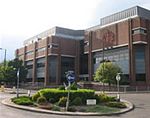Kodak Harrow
1891 establishments in EnglandBuildings and structures in the London Borough of HarrowChemical industry in LondonHistory of the London Borough of HarrowKodak

The Kodak Works, Harrow was a photographic manufacturing plant and research and development centre on Headstone Drive, Harrow, North West London. Built by the American Kodak company in 1890, it was their largest factory in the United Kingdom and at its peak in the mid-20th century employed up to 6,000 workers. Production of photographic film ended in 2005 and the plant closed its doors in 2016.
Excerpt from the Wikipedia article Kodak Harrow (License: CC BY-SA 3.0, Authors, Images).Kodak Harrow
Hargrave Drive, London Harrow Weald (London Borough of Harrow)
Geographical coordinates (GPS) Address Nearby Places Show on map
Geographical coordinates (GPS)
| Latitude | Longitude |
|---|---|
| N 51.5945 ° | E -0.3458 ° |
Address
Kodak
Hargrave Drive
HA1 4GF London, Harrow Weald (London Borough of Harrow, Kodak)
England, United Kingdom
Open on Google Maps










